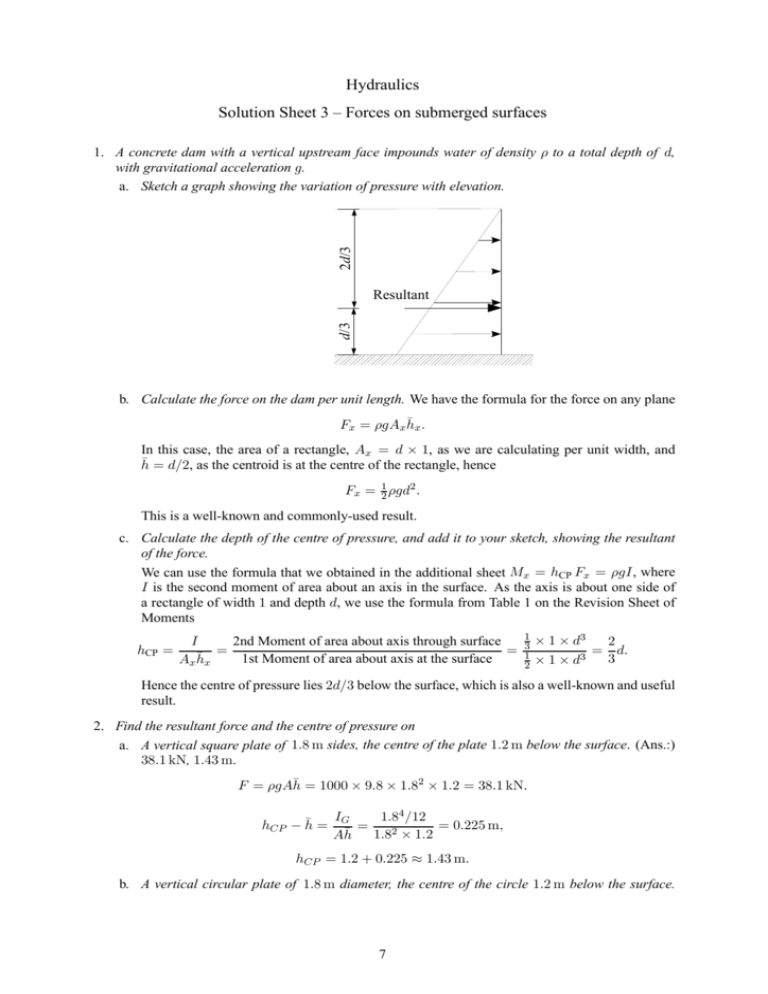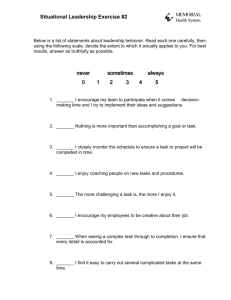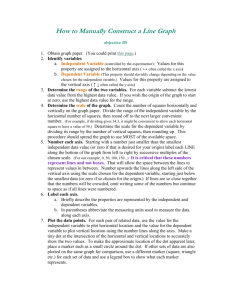Hydraulics Solution Sheet 3 – Forces on submerged surfaces
advertisement

Hydraulics
Solution Sheet 3 – Forces on submerged surfaces
2d/3
1. A concrete dam with a vertical upstream face impounds water of density ρ to a total depth of d,
with gravitational acceleration g .
a. Sketch a graph showing the variation of pressure with elevation.
d/3
Resultant
b. Calculate the force on the dam per unit length. We have the formula for the force on any plane
Fx = ρgAx h̄x .
In this case, the area of a rectangle, Ax = d × 1, as we are calculating per unit width, and
h̄ = d/2, as the centroid is at the centre of the rectangle, hence
Fx = 12 ρgd2 .
This is a well-known and commonly-used result.
c. Calculate the depth of the centre of pressure, and add it to your sketch, showing the resultant
of the force.
We can use the formula that we obtained in the additional sheet Mx = hCP Fx = ρgI , where
I is the second moment of area about an axis in the surface. As the axis is about one side of
a rectangle of width 1 and depth d, we use the formula from Table 1 on the Revision Sheet of
Moments
hCP =
2nd Moment of area about axis through surface
I
=
=
1st Moment of area about axis at the surface
Ax h̄x
1
3
1
2
× 1 × d3
2
= d.
3
3
×1×d
Hence the centre of pressure lies 2d/3 below the surface, which is also a well-known and useful
result.
2. Find the resultant force and the centre of pressure on
a. A vertical square plate of 1.8 m sides, the centre of the plate 1.2 m below the surface. (Ans.:)
38.1 kN, 1.43 m.
F = ρgAh̄ = 1000 × 9.8 × 1.82 × 1.2 = 38.1 kN.
hCP − h̄ =
IG
1.84 /12
= 0.225 m,
=
1.82 × 1.2
Ah̄
hCP = 1.2 + 0.225 ≈ 1.43 m.
b. A vertical circular plate of 1.8 m diameter, the centre of the circle 1.2 m below the surface.
7
(Ans.: 29.9 kN, 1.37 m.)
F = ρgAh̄ = 1000 × 9.8 × π/4 × 1.82 × 1.2 = 29.9 kN.
hCP − h̄ =
IG
π × 1.84 /64
= 0.169 m,
=
π1.82 /4 × 1.2
Ah̄
hCP = 1.2 + 0.169 ≈ 1.37 m.
dW
dO
3. The cylindrical boom shown is required to retain a spill of oil of depth do and relative density σ o by
floating in seawater of relative density σ w .
a. Show that the seawater on the other side of the boom rises to a depth of dw = do σ o /σ w above
the oil-water interface.
The pressure on the underside of the oil (pressure equals density of fluid ×g×depth) is ρσ o gdo .
Applying the hydrostatic pressure equation between a point in the seawater just under the oil
and a point on the other side of the boom at the same elevation,
ρσ o gdo = pressure due to seawater = ρσ w gdw ,
∴ dw = do σ o /σ w
b. Show that the horizontal force on the boom per unit length is
2
1
2 ρσ o gdo (1 − σ o /σ w ) ,
where ρ is the density of fresh water.
To calculate the force per unit length we exploit our knowledge (actually about to be obtained
in the next question) that the force per unit length on a depthvertical rectangular shape, here the
projection of the boom, is 1/2×density×g×depth2 :
Force to right due to oil above interface =
Force to left due to seawater above level of interface =
2
1
2 ρσ o g do
2
1
2 ρσ w g dw .
Below the level of the interface the problem is symmetric, hence, the net force is
¡
¢
F = 12 ρg σ o d2o − σ w d2w ,
however using the result for dw from part (a),
¡
¢
F = 12 ρg σ o d2o − σ w d2o σ 2o /σ 2w
=
2
1
2 ρgσ o do (1
− σ o /σ w ) .
c. In which direction is the force? What implication does this have for the stability of such flexible
booms in retaining oil spills? What plan shape do you think a flexible boom would take up?
The force is to the right, as σ o /σ w is less than 1. This means that the boom will will be pushed
outwards by the oil, so that the configuration is generally stable, and we expect it to tend to a
circle in plan.
4.
8
A
C
B
A vertical bulkhead in a ship has a door which has to be designed such that it will not be forced
open if part of the ship fills with seawater of density 1025 kg m−3 . The door is 2 m high and 1 m
wide, and the sea surface is assumed to be 1 m above the top of the door.
a. Calculate the force on the door and its position.
The total force on the door is
F = ρgAh̄ = 1025 × 9.8 × 2 × 1 × (1 + 2/2) = 40.2 kN
The position of the centre of pressure is
hCP − h̄ =
IG
1 × 23 /12
= 0.167 m,
=
2 × 1 × (1 + 2/2)
Ah̄
hence it is 1.167 m below the top of the door. By symmetry, it is in the left-right centre of the
door.
b. The door is fastened by two hinges A and B on one vertical edge, 15 cm from top and bottom,
and by a latch C in the centre of the other vertical edge. Calculate the forces on each hinge and
on the latch when one face of the bulkhead is subject to water pressure (Ans.: 20.1 kN, 6.1 kN,
14.0 kN).
Now take moments about the axis AB - the moment arm of the force at C is twice that of the
water force, hence FC = 40.2/2 = 20. 1 kN.
Now take moments about a horizontal axis through B. The moment arm of FA is 2 −2 × 0.15 =
1. 7 m. The moment arm of FC is 1 − 0.15 = 0.85 m. The water force is 0.167 m below the
centroid, hence it has a moment arm of 0.85 − 0.167 = 0.683 m.Hence
FA × 1. 7 + FC × 0.85 − 40.2 × 0.683 = 0
FA × 1. 7 = −20.1 × 0.85 + 40.2 × 0.683
FA = 6.1 kN
To evaluate the remaining force we just consider horizontal equilibrium and obtain
FB = 40.2 − 20.1 − 6.1 = 14.0 kN
5. A mixing tank with trapezoidal ends is 1.8 m long, 0.9 m deep and 0.9 m wide at the top, tapering
to 0.3 m wide at the base. If the tank is completely filled with water, calculate
a. The total weight force of water in the tank.
9
0.9m
0.9m
1.8m
0.3m
The area of one end is
1/2 × 0.9 × (0.3 + 0.9) = 0.54 m2
Hence the volume is 0.54×1.8 = 0.972 m3 , and the total weight is ρgV = 1000×9.8×0.972 ≈
9.5 kN.
b. The total force exerted by water on the base.
F
= Weight of water which would occupy the volume between base and surface
= ρgV = 1000 × 9.8 × 0.9 × 0.3 × 1.8 ≈ 4.8 kN
c. The total force exerted on one end and where it acts. To do this it will be necessary to calculate
the first and second moments of area of the trapezium which forms the face about an axis along
the top of the trapezium, the water level.
i. The first moment of area MO = Ah̄ can be calculated by using known properties of rectangles and triangles. It is suggested that you calculate it that way (MO = 0.2025 m3 ).
ii. Then, to check – and to prepare for the next part – set up and evaluate an integral for that
first moment of area in terms of the width b of the trapezium as a function of depth h.
iii. Then, set up and evaluate a similar integral for the second moment of area IO , so that you
can use the expression hCP = IO /MO .
Solution:
i. To do this we first have to calculate Ah̄, which is the first moment of area of the trapezium
about the surface. We can use the fact that the centroid of a triangle is 1/3 of its height from
its base.
¯
¯
Ah̄ = Ah̄¯square + 2 × Ah̄¯triangle
= 0.9 × 0.3 ×
= 0.2025 m3
1
2
× 0.9 + 2 ×
1
2
× 0.3 × 0.9 ×
1
3
× 0.9
ii. The width of the trapezium at h below the surface is b = 0.9 − 0.6h/0.9 = 0.9 − 2h/3.
Z 0.9
MO =
bh dh
0
Z 0.9
=
(0.9 − 2h/3) h dh
0
= 0.2025 m3
Hence F = ρgAh̄ = 1000 × 9.8 × 0.2025 = 1.98 ≈ 2.0 kN.
iii. Now to calculate its position we use
sCP =
IO
ρg sin θ IO
=
,
ρg sin θ As̄
As̄
10
so we must also calculate IO of the trapezoid.
Z 0.9
IO =
bh2 dh
0
Z 0.9
=
(0.9 − 2h/3) h2 dh
0
= 0.1094 m4 ,
and so
hCP =
0.1094
= 0.54 m from the surface
0.2025
D = 3m
6. A sluice gate consists of a radial gate of radius 2 m pivoted at its centre O, as shown in the figure.
Calculate the magnitude and direction of the resultant force on the gate due to the water, and the
net moment required to open the gate.
Gate B = 2m wide
F
R = 2m
The horizontal component on the gate is equal to the horizontal force on the projection onto a vertical plane of height R and width B with its top edge D below the surface. The force is
µ
¶
R
Fx = ρgAx h̄x = ρgBR D +
.
2
The position of the centre of pressure is that of the centre of pressure of the projection onto a vertical
plane, which is a rectangle of dimensions B × R, however the top edge is still D below the surface,
so we cannot just use the formula 13 bd3 . We could use the parallel axes theorem, however it is more
intuitive here to calculate the net second moment of a large rectangle of total depth D + R with
edge at the surface minus that of a rectangle of depth D but also with edge at the surface:
¢
¡
I = 13 B (D + R)3 − 13 BD3 = BR 13 R2 + RD + D2 .
In case anybody is disappointed that we didn’t use the Parallel Axes Theorem, here it is, using the
1
second moment of area of a rectangle about an axis through the centroid 12
BR3 plus the area times
the square of the distance between surface axis and centroid BR × (D + R/2)2 :
¶
µ
¡
¢
R 2
3
1
I = 12 BR + BR × D +
= BR 13 R2 + RD + D2
2
showing that the intuitive method worked. Now,
hCP =
1 2
R + RD + D2
I
= 3
.
Ax h̄x
D + R2
Now the vertical force is equal to the weight force on the fluid which would occupy the region
between the level of the free surface and the surface on which we are to calculate the force. In this
case this is the volume occupied by the quadrant of the gate plus the rectangular region above that.
´
³π
´
³π
R2 + DR = ρgBR
R+D
Fz = ρgV = ρgB
4
4
11
This force acts through the centre of gravity of that volume – and is upwards. To find this we take
moments of volume about an axis through O (to do this we need to know that the distance of the
centroid of a semi-circle or quadrant is 4/ (3π) times the radius from the centre of the circle):
µ
¶
4R
2
1
1
Total moment of vertical force about O = ρgB 4 πR ×
+ DR × 2 R
3π
µ
¶
D
2 R
+
= ρgBR
3
2
Thus, the vertical force acts a horizontal distance of x̄ from O:
¡
¢
¢
¡
ρgBR2 R3 + D
R R3 + D
Moment of vertical force
2
2
¡
¢= π
x̄ =
=
Fz
ρgBR π4 R + D
4R + D
Now we calculate the net moment of the horizontal and vertical forces about O:
¶
µ
D
2 R
+
− Fx (hCP − D)
Net moment = ρgBR
3
2
!
µ
¶
µ
¶Ã1 2
2
D
R
2 R
3 R + RD + D
+
−D
= ρgBR
− ρgBR D +
3
2
2
D + R2
= 0! As it should be in this radial gate case.
Now we put numbers in: B = 2 m, D = 3 m, R = 2 m, and ρ = 1000 kg m−3 and g = 9.8 m s−2 :
¶
µ
R
= 1000 × 9.8 × 2 × 2 × (3 + 2/2) = 157 kN
Fx = ρgBR D +
2
1 2
R + RD + D2
hCP = 3
= 4.083 m
D + R2
´
³π
R + D = 179 kN
Fz = ρgBR
¡ R 4D ¢
R 3 + 2
= 0.948 m
x̄ =
π
4R + D
Thus, a horizontal force of 157 kN acts to the right, a distance of 4.083 − 3 = 1.083 m below
the pivot, and the vertical force of 179 kN acts vertically upwards (the gate is above the water) a
horizontal distance of 0.948 m from the pivot.
√
The resultant force is 1572 + 1792 = 238 kN, at an angle to the horizontal of arctan (179/157) =
0.851rad≈ 49◦ .
Net moment of pressure forces about pivot
Net moment of pressure forces about pivot = 157 × 1.083 − 179 × 0.948 ≈ 0
to our order of accuracy. This result is expected, as every element of the pressure force is perpendicular to the arc, so that the line of action of the resultant is through the pivot, and there is no moment,
the reason for using radial gates.
7. A spherical container is made up of two hemispheres, the joint between the two halves being horizontal. The sphere is completely filled with water through a small hole in the top. It is found that
50kg of water are required for this purpose. If the two halves of the container are not secured together, what must be the mass of the upper hemisphere if it just fails to lift off the lower hemisphere?
(Ans.: 12.5 kg).
12
The force in the direction of gravity is equal to the weight force on the fluid which would occupy a
volume between the surface on which the force is to be calculated and the plane of the free surface.
That is, it is the region between the upper hemisphere, and the level of the water surface, which
forms a cylinder of radius r and height r. The direction of the force is upwards.
2
|πr {z× r} −
The volume of this region =
Vol. of cylinder
=
3
1
3 πr ,
1
|2
× 43 πr 3
{z }
Vol. of hemisphere
hence the mass of water in that region is m = ρ 13 πr3 . However the mass of water which fills the
sphere is 50 kg, hence
ρ 43 πr3 = 50,
and m = 50/4 = 12.5 kg.
8. The corner of a tank is bevelled by equal dimensions d as shown in the figure. It is filled to h above
the top of the bevel. What is the force on the triangular corner?
d+h
z
d Z
O
x
d
d
X
Y
y
Force in x direction = Force on projection OYZ
¡
¢ ρgd2
= ρgAOY Z h̄OY Z = ρg × 12 d2 × h + 23 d =
(3h + 2d)
6
= Force in y direction by symmetry
Force in z direction = Weight force on prism above XYZ
d2 1
ρgd2
× 3 (h + d + h + d + h) =
(3h + 2d) .
= ρg × Volume = ρg ×
2
6
Thus, each of the force components is the same. This is what we would expect for such a surface
whose direction cosines are the same for all 3 directions.
13






